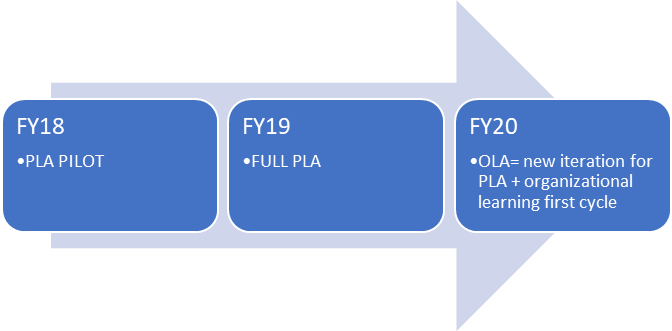This article serves as an overview of the purpose, structure and history of iMentor's Organization-wide Learning Agenda. Use the quick links below to more quickly navigate to sections of interest:
- Overview
- Why are we doing this?
- How is the OLA run?
- What is the vision for collaboration?
- Historical timeline
- What aspects of our program have we looked at?
- What are we looking at in FY20?
Overview
The Organization-wide Learning Agenda (OLA) is a recurring org-wide learning project about iMentor’s organizational and program effectiveness, all of which is designed to achieve impact for our students and our organization. The OLA project was created in connected with iMentor's 2018-2023 Strategic Plan. The strategic plan outlines that by 2023 iMentor will:
2. Expand our impact and influence beyond the reach of our programs by leveraging our unique assets, including: 1) harnessing our data and knowledge to share our insights with the field and 2) educating and mobilizing our mentor community around issues of equity and education.
3. Position iMentor for organizational excellence at a national scale by 1) developing into a more mature organization and (2) increasing our financial sustainability.” [page 38]
In order to accomplish this vision, iMentor plans to improve our communication and collaboration, our data-driven decision making and performance management, and our learning and continuous improvement efforts; all of this work done with a diversity, equity, and inclusion lens. The Organizational Learning & Impact (OLI) team created the structure of the OLA to support many of our learning priorities articulated within our five-year strategic plan.
Why are we doing this?
The main reason iMentor has an Organization-wide Learning Agenda is to generate a deeper understanding about the program and organization processes and outcomes to improve organizational effectiveness in decision-making and to increase program impact through action.
How is the OLA run?
The OLI team at iMentor is responsible for running this project with the collaboration of an Advisory Group and other stakeholders based on their functional interest in the insights being shared. In cycles, the OLI team conducts new research and analyzes existing data to answer organizational learning questions and questions specifically about our program’s design, implementation, and outcomes.
What is the vision for collaboration?
The participation of stakeholders in each cycle (learning question-->answer-->change-->assess) is a key element of the OLA. Leaders in different roles and regions engage in identifying the most pressing questions, interpreting findings, and producing recommendations to bring about change. This joint effort is critical to the communication of the content of this work to the broader iMentor community. The OLI team and collaborators engage with these results on a regular basis in order to inform future iterations of analysis.
The OLA Advisory Group functions as the task force for this project, engaging with the OLI team in the following:
- Bringing pressing questions about our organization and actionable aspect of our program
- Reacting to analysis in real-time
- Engaging in making sense of data and in producing insights
- Sharing learnings with their teams
Historical Timeline
The OLA project started as the Programmatic Learning Agenda (PLA) project with a focus on learning about our program effectiveness. The first year was the pilot year (FY18), that consisted of one week of the then Research & Evaluation team endeavor in which they answered two questions about our program. The second year (FY19) was the full rollout of the PLA project, answering five programmatic questions. The third and current year (FY20) has started a new learning cycle about the program and expanded to including questions about organizational learning.

What aspects of our program have we looked at?
During FY18, the team looked at the pairs that completed their full length of match to learn about mentor characteristics and program elements associated with match persistence; and analyzed patterns for our students’ college enrollment and persistence. Through the FY19 PLA, the OLI team created insights about the association between iMentor program elements and high-school graduation and college enrollment; programmatic and non-programmatic characteristics of strong pair relationships; participation patterns; fidelity of program implementation; and the relationship between enrollment in PSP and college persistence. A summary of main takeaways can be found in this Learning Center article. And, this deck has the full FY19 PLA results.
What are we looking at in FY20?
This year the plan is to continue learning about what strong pair relationships look like at iMentor, from mentor and student perspectives, and the model fidelity of implementation for both the high-school and the PSP programs. New topics will address mentor engagement and outcomes for students, what and how student learn, student participation in PSP and student success with their post-secondary path, student experiences with college, and the work to achieve the org strategic objectives goals.

